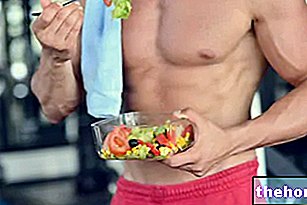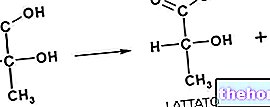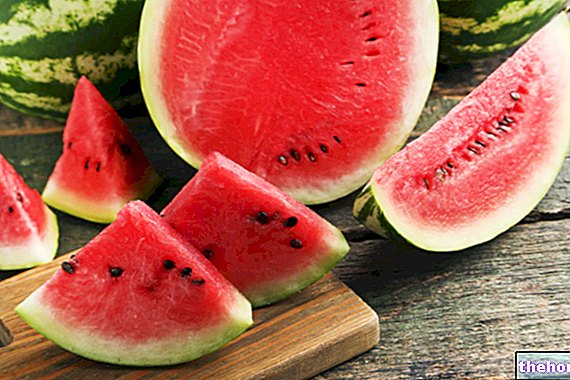
Hunger crises typically affect endurance athletes (cyclists, marathoners ...), while they are almost non-existent among athletes engaged in shorter and more intense efforts. Furthermore, hunger crises often affect amateur athletes and beginners, either because they are inexperienced in managing their diet based on their efforts, or because they are poorly efficient - from a metabolic point of view - in saving glycogen by oxidizing high percentages of fatty acids. at medium to high intensity levels.
for carrying out physical activity.In sports practice, energy consumption inexorably increases; this greater demand is satisfied by the hydrolysis-oxidation of the energy molecules:
- creatine-phosphate [C-P]
- carbohydrates [CnH2nOn]
- fatty acids [CH3- (CH2) n-COOH]
- branched chain amino acids [leucine, isoleucine and valine]
- substrates for neoglucogenesis (amino acids [NH2-CH-R-COOH], glycerol, lactic acid, pyruvate).
There are no energetic metabolisms separated from each other and normally they are simultaneous as well as mixed with each other; however - based on: level of training, metabolic efficiency, type of effort, duration of effort, nutritional status, subjectivity, etc. - more than significant intra and inter-individual differences can be highlighted. Despite this, it is still possible to assert that, even considering the aforementioned variables, in the energy expenditure and in the prevalence of metabolic pathways:
carbohydrates (glucose) are ALWAYS part of the energy production mechanism, both in aerobic and anaerobic efforts or mixed.
Carbohydrates or carbohydrates in the body derive from food (simple and complex) but can also be largely produced endogenously by means of neoglucogenesis (settling for limited "effectiveness and" efficiency); in basal conditions, it is therefore possible to survive (but not always live in perfect psycho-physical health) even by drastically limiting them in the diet. On the contrary, carrying out aerobic sports that require a high intensity of effort, it is necessary that the organism is constantly EU-nourished, that is, that it is in a perfect state of nutrition; "Glycemic homeostasis and the consistency of glycogen reserves are fundamental criteria in evaluating the nutritional status of a subject (therefore also of a sportsman) who, not taking carbohydrates with the diet, could not count on an effective recovery of the reserves of sugars. The latter can and must be stored, however, feeding mainly on molecules that require intense metabolic commitment to be converted into glucose and subsequently stored in the muscle and liver (amino acids of proteins and glycerol of triglycerides), it is not possible to reach levels of nutritional COMPENSATION sufficiently rapid and consistent.
Ultimately, for an endurance sportsman (cycling, cross-country swimming, cross-country skiing, cross-country running, cross-country rowing, tracking, etc.), eating unbalanced would mean risking the onset of hunger during performance due to " exhaustion of sugars, and more precisely of muscle glycogen.
The glycogen reserves have a LIMITED CAPACITY; the muscle ones can be increased with training .... but up to a certain point! NB. the consistency of glycogen reserves in athletes is assessed by means of a parameter called AEROBIC RESISTANCE (time required to exhaust the reserves during an aerobic threshold effort). From a quantitative point of view, glycogen does NOT represent a GOOD reserve; to be stored it needs "large spaces", because its chemical bonds also include a "high quantity of" water (almost absent in the fat reserves: adipose tissue); it is estimated that 2.7g of water are required for each gram (g) of glycogen.
Assuming a COMPLETE depletion of muscle glycogen stores (a condition almost impossible to achieve in sport, as the hunger crisis occurs slightly earlier) it would mean a reduction in body mass of:
300g x (1g + 2.7g) = 1110g ... or 1.1kg
to it should also be added a percentage of hepatic depletion, since the liver, although NOT directly responsible for muscle energy sustenance but for glycemic maintenance, in conditions of metabolic greed releases as much glucose as is necessary for glycemic homeostasis. although it is mainly responsible for the correct functioning of the central nervous system (CNS), during sporting activity it participates in the muscular energy supply.
in the most suitable way and allows your body to recover from the physical stress induced by training.The diet suitable for preventing hunger crises during sport is characterized by a consistent base of complex carbohydrates well distributed in meals; it is possible to follow the general recommendations for a correct diet, therefore it would be advisable to guarantee a quantity of carbohydrates oscillating between 55 and 60% of total calories. Proteins should not exceed 1.5 g / kg of body weight (possibly supported by an "integration of branched amino acids) and lipids should be between 25 and 30% of total energy. NB We remind you that, even in sports (especially amateur) it is possible to introduce more energy than necessary with the risk of favoring adipose deposition, therefore overweight.
What differentiates the diet of an endurance athlete who wants to prevent hunger crises from that of a sedentary person is the distribution energy in the various meals of the day. Sportsmen (and especially athletes) carry out particularly demanding physical activities that significantly contribute to the "increase in caloric needs; assuming that a subject X has a daily energy expenditure of 2300kcal (basal metabolic rate + usual activities), after an afternoon cross-country cycling training (from 16:00 to 18:15) could easily reach the 3500-4000 kcal TOT; to distribute them correctly, those provided by carbohydrates should be distributed throughout the day ... BUT with greater density BEFORE, DURING and IMMEDIATELY AFTER physical activity! A simple and effective method (for a novice and not for a nutrition professional who SHOULD be a little more accurate ...) could be the following:
- Organize daily meals away from training in an ordinary way (in this case: breakfast, morning snack, lunch [...] training ... and dinner).
- Compose a PRE-workout meal (whether main or secondary) with low glycemic index carbohydrate-based foods rich in dietary fiber (moderating lipids and proteins) to consume about 90-120 " before the effort; for example 100g of "basmati" rice seasoned with 100g of vegetables, 10g of extra virgin olive oil and 10g of grated cheese (about 450 kcal).
- Integrate DURING sports activity with maltodextrin dissolved in water, if necessary with branched amino acids and mineral salts, structuring a slightly hypotonic drink of at least 1-1.5 liters and about 300-350kcal.
- In the immediate POST workout (even before the shower!), Compose an additional meal based on medium and high glycemic index carbohydrates with low fat and low protein. An example could be: 200g of potatoes dressed with extra virgin olive oil, 2 slices of white bread and 1 banana (about 400kcal).
On balance, to avoid the hunger crisis during sport due to the exhaustion of muscle glycogen, it is NECESSARY:
- Introduce the right amount of energy
- Introduce the right amount of carbohydrates
- Properly distribute nutrients
- Properly distribute daily meals
- Leave the right recovery to the body
- Dose the energy during the performance to avoid premature exhaustion of glycogen stores.




























